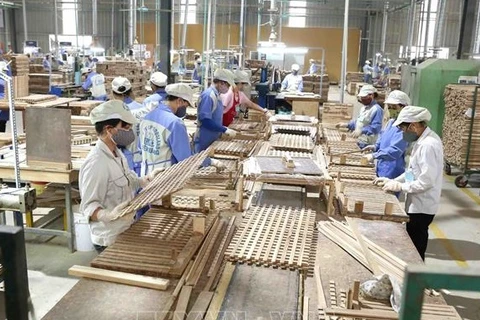Hanoi (VNA) – The Ministry of Agriculture and Rural Development (MARD) set a target of growing about 1 million ha of large-sized timber forests nationwide by 2030.
Of the area, the 500,000 ha of existing large-sized timber forests will be maintained and another 450,000-550,000 ha grown during 2024-2030, according to the MARD’s plan on the development of large-sized timber forests for the period.
The ministry said that the development of concentrated large-sized timber forests aims to ensure sufficient timber supply for processing to serve the domestic market and export, increase forest growers’ income, and help with environmental protection, climate change response, and disaster mitigation.
Productivity of the forests with intensive cultivation of such trees as “keo” (Acacia) and “bach dan” (Eucalyptus) will be raised to an average of 20 cu.m. per ha each year by 2025 and 22 cu.m. per ha each year by 2030. Income from commercial forests will be increased by about 1.5-2 times per unit of area compared to 2020. Besides, the forestry production value chain will also be promoted.
Meanwhile, the 450,000-550,000 ha of new large-sized timber forest will be developed in six socio-economic regions. That comprises 130,000-146,000 ha in the northern midland and mountainous region, 6,000-9,000 ha in the Red River Delta, 280,000-348,000 ha in the north central and coastal central region, 25,000-35,000 ha in the Central Highlands, 7,500-10,000 ha in the southeastern region, and 1,500-2,000 ha in the southwestern region.
To realise those targets, the MARD devised several measures in its plan, including reviewing the land reserves and small-sized timber forests eligible for development, connecting forest growers with businesses, and promoting sustainable forest management and forest certification.
It will also step up the development of high-yield and high-quality plant varieties that meet the market’s demand and are resistant to diseases and adverse environmental conditions to use for afforestation.
Favourable mechanisms and policies such as exempting or reducing land rent and land use tax, supporting investment, and providing soft loans to attract private resources to developing large-sized timber forests./.
Of the area, the 500,000 ha of existing large-sized timber forests will be maintained and another 450,000-550,000 ha grown during 2024-2030, according to the MARD’s plan on the development of large-sized timber forests for the period.
The ministry said that the development of concentrated large-sized timber forests aims to ensure sufficient timber supply for processing to serve the domestic market and export, increase forest growers’ income, and help with environmental protection, climate change response, and disaster mitigation.
Productivity of the forests with intensive cultivation of such trees as “keo” (Acacia) and “bach dan” (Eucalyptus) will be raised to an average of 20 cu.m. per ha each year by 2025 and 22 cu.m. per ha each year by 2030. Income from commercial forests will be increased by about 1.5-2 times per unit of area compared to 2020. Besides, the forestry production value chain will also be promoted.
Meanwhile, the 450,000-550,000 ha of new large-sized timber forest will be developed in six socio-economic regions. That comprises 130,000-146,000 ha in the northern midland and mountainous region, 6,000-9,000 ha in the Red River Delta, 280,000-348,000 ha in the north central and coastal central region, 25,000-35,000 ha in the Central Highlands, 7,500-10,000 ha in the southeastern region, and 1,500-2,000 ha in the southwestern region.
To realise those targets, the MARD devised several measures in its plan, including reviewing the land reserves and small-sized timber forests eligible for development, connecting forest growers with businesses, and promoting sustainable forest management and forest certification.
It will also step up the development of high-yield and high-quality plant varieties that meet the market’s demand and are resistant to diseases and adverse environmental conditions to use for afforestation.
Favourable mechanisms and policies such as exempting or reducing land rent and land use tax, supporting investment, and providing soft loans to attract private resources to developing large-sized timber forests./.
VNA























